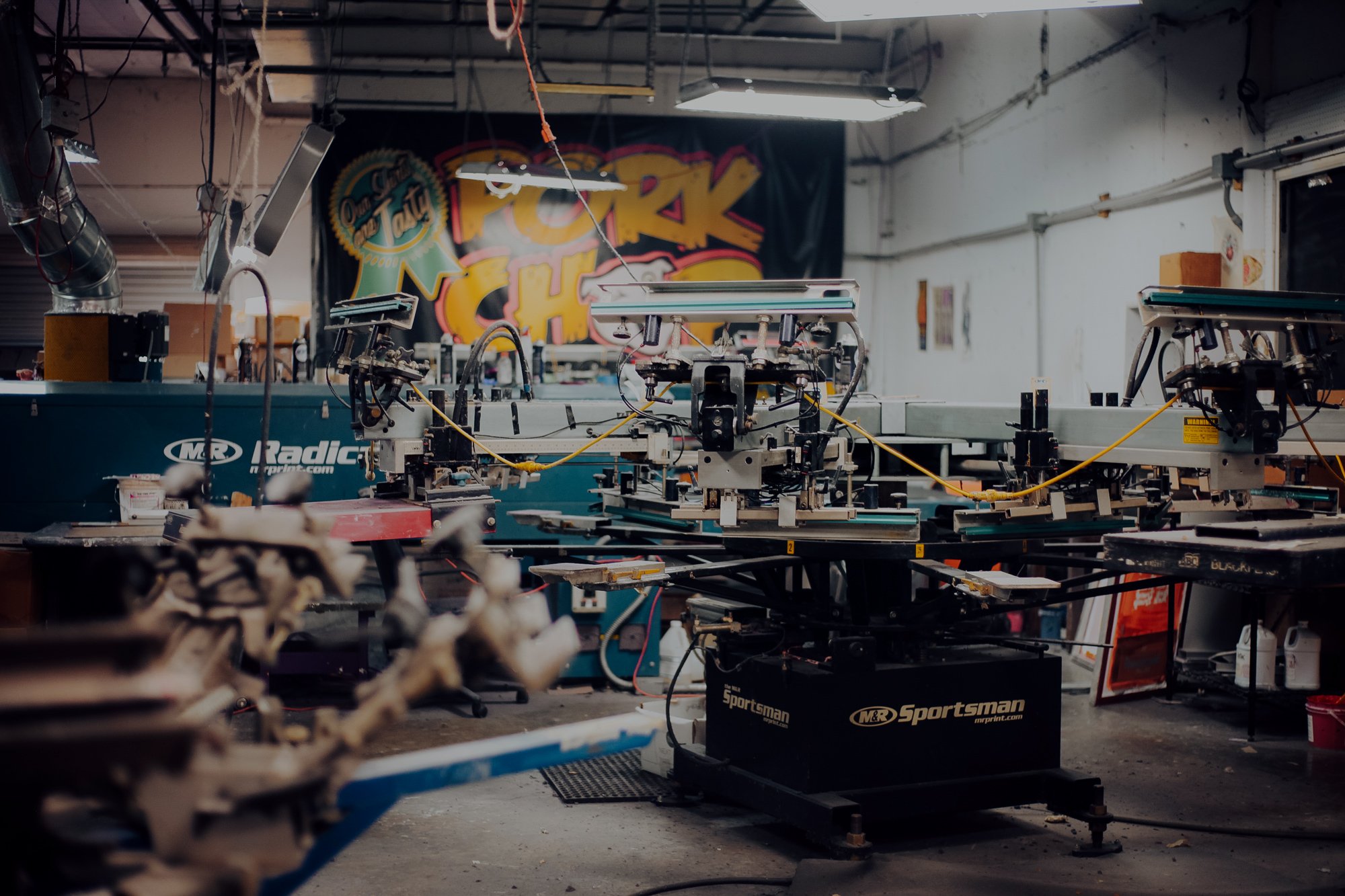Display Printing Uncovered: Every Little Thing You Need to Understand About T-Shirt and Garment Printing Methods
Screen printing is an interesting method that combines art with technique, offering endless possibilities for creativity. Ready to check out the important aspects that make display printing an art form?
The Essentials of Display Printing: How It Functions
When you plunge right into screen printing, you'll uncover it's both an art and a scientific research. At its core, screen printing includes creating a pattern, or screen, that enables ink to pass with just in specific locations.
Setting the display over the textile, then make use of a squeegee to push ink with the screen onto the garment. Each step is crucial, and mastering them will boost your display printing abilities, changing easy garments into distinct, meaningful pieces.
Kinds Of Display Printing Techniques
Once you understand the basics of display printing, it's time to check out the different strategies that can raise your styles. One prominent method is typical display printing, where ink is pressed via a stenciled display. This technique is excellent for bold, vivid colors. After that there's water-based ink printing, which provides a softer feeling and is environment-friendly, yet it calls for a different strategy to curing.
Another option is plastisol printing, known for its durability and dazzling colors, making it a preferred for many brands. Experiment with halftone printing to create slope impacts and elaborate designs.
Necessary Equipment for Display Printing
To attain sensational outcomes in screen printing, having the right devices is fundamental. You'll need a tough screen printing frame, which holds the mesh that transfers your style onto the garment. Next off, invest in top quality mops; these are essential for using ink equally across the display.
Choosing the Right Inks and Products
When choosing inks and products for display printing, you need to take into account the sort of ink that works ideal for your task. Consider fabric compatibility to ensure your styles look wonderful and last long. Also, check out environment-friendly ink choices to make your printing process much more sustainable.
Kinds of Screen Inks
Choosing the ideal screen ink is important for attaining vivid, long lasting prints that satisfy your job's demands. There are numerous types of screen inks to examine. Specialty inks, such as metal or glow-in-the-dark, can include one-of-a-kind impacts to your layouts.

Textile Compatibility Considerations
Recognizing fabric compatibility is crucial for achieving high-quality display prints, particularly considering that different products respond uniquely to different inks. Constantly check your inks on example material to ensure they stick effectively and keep color stability. In addition, maintain in mind that material weight and structure can influence the final result, so selecting the right ink and material combo is crucial for your task's success.
Eco-Friendly Ink Options
Green inks are ending up being a preferred choice for display printers that intend to lessen their environmental effect while maintaining high quality. When selecting inks, take into consideration water-based inks, which are much less hazardous and less complicated to clean up compared to traditional solvents. These inks bond well with materials, delivering dynamic outcomes without hazardous chemicals. You might additionally discover eco-solvent inks that use less unpredictable natural substances (VOCs), making them a safer option for both your health and the earth.
In addition, look for inks made from renewable energies, such as soy or vegetable-based choices. By selecting the ideal inks and products, you'll not just develop stunning designs however additionally add to a more sustainable printing process. Make the switch, and your prints will certainly mirror your dedication to the environment!
Preparing Your Style for Display Printing

File Layout Demands
To assure your design looks sharp and vivid on textile, you'll need to pay very close attention to file format demands for display printing. Begin with vector files like AI or EPS, as they can be scaled without advice shedding high quality. If you utilize raster photos, go with high-resolution data, such as TIFF or PNG, preferably at 300 DPI. Avoid utilizing JPEGs, as they can lose clearness when resized. Make certain your design has a clear background to protect against unwanted white edges on your prints. Maintain shade settings in mind; CMYK is conventional for display printing, so transform your RGB develops as necessary - screen printing kit. By following these guidelines, you'll set your artwork up for an effective print.
Color Splitting Up Techniques
Color splitting up is an important action in preparing your design for display printing, and mastering it can greatly improve your print top quality. You'll need to damage your style into specific colors, as each color calls for a different screen during printing. Beginning by recognizing all the shades in your style and produce layers for each one. You can use software like Adobe Photoshop or Illustrator to separate and different shades properly. Be particular to conserve each layer as a different documents, typically in a style like TIFF or PSD. This accuracy not just assures accurate color representation however likewise simplifies the printing process. By paying interest to shade splitting up, you'll attain vibrant and expert lead to your screen-printed garments.
Resolution and Dimension
Achieving the most effective cause display printing begins with ensuring your design has the best resolution and size. Preferably, your art work needs to go to least 300 DPI (dots per inch) for sharp, clear prints. Your final product could look pixelated and less than professional. if you utilize reduced resolution.
When it concerns dimension, consider the dimensions of your print location. Layout your artwork to match the final print dimension, preferably creating it in the actual measurements you'll be printing. By doing this, you'll stay clear of any type of unanticipated scaling issues.
Always examine your design in both vector and raster styles. Vector graphics can be scaled without losing quality, making them ideal for display printing. Preparing correctly will guarantee your style looks outstanding on every garment!
Step-by-Step Display Printing Process
Screen printing is a dynamic procedure that permits you to create dynamic styles on different surface areas. To start, you'll require a screen, emulsion, and your chosen ink. First, prepare your screen by cleaning it completely. Next, apply the emulsion evenly and let it dry in a dark area. When dry, subject your display to light with your style put on More Help it, which will solidify the solution where the light hits, creating a pattern - screen printing kit.
Put ink onto the display and make use of a squeegee to push the ink with the stencil onto the fabric. Lift the screen thoroughly and allow the print completely dry. You've successfully screen printed your design.
Tips for Effective Screen Printing Projects
While you're diving right into your display printing tasks, keep in mind that preparation is key to success. Begin by collecting all your materials-- inks, squeegees, garments, and screens. A tidy work area aids stop undesirable errors, so clean up before you start.
Next, confirm your artwork is high-resolution and effectively sized for your garment. Check your screen for appropriate exposure and tidy it completely to avoid spots. When mixing your inks, follow the maker's guidelines to accomplish the appropriate consistency.
Throughout printing, use even pressure with your squeegee for regular results. Don't hurry; take your time to validate each print meets your requirements. After printing, allow your garments dry entirely before managing or packaging them.
Lastly, constantly maintain a sample of your help future referral. This method, you can assess your development and improve your methods with time. Pleased printing!

Frequently Asked Concerns
How Lengthy Does It Require To Establish a Screen Printing Work?
Establishing a screen printing work generally takes about 30 minutes to an hour. You'll prepare the displays, mix inks, and readjust the press. The time varies based upon intricacy and experience, so stay organized!
Can I Publish on Various Material Types Using the Very Same Strategy?
Yes, you can print on different fabric kinds utilizing the exact same method, but you'll require to readjust your inks and settings. Some fabrics soak up ink in different ways, so trying out warranties the most effective outcomes for each and every product.
What Are Typical Mistakes to Stay Clear Of in Display Printing?
When display printing, prevent common mistakes like using the wrong ink, ignoring proper direct exposure times, or avoiding pre-press checks. Always check your setup and keep clean displays to ensure top quality results each time.
Just How Can I Appropriately Clean and Preserve My Display Printing Devices?
To properly tidy and maintain your display printing equipment, you need to consistently wash displays with suitable solvents, examine squeegees for wear, and assure all tools are saved dry and dust-free. Consistency improves and prevents pricey repair services performance.
Is Display Printing Eco-friendly Contrasted to Other Approaches?
Screen printing can be a lot more environmentally friendly than various other approaches, especially if you utilize eco-conscious materials and water-based inks. By choosing sustainable materials and techniques, you reduce waste and reduce your effect on the earth.
Screen Printing Uncovered: Everything You Need to Know Concerning Tee and Garment Printing Techniques
At that site its core, screen printing includes producing a pattern, or display, that permits ink to pass through just in specific areas. Setting the display over the fabric, then use a squeegee to press ink through the display onto the garment. One preferred technique is traditional screen printing, where ink is pressed through a stenciled display.When selecting inks and materials for screen printing, you require to take right into account the kind of ink that functions ideal for your project.